| |||||||
 |
| Search this Thread |  1,080,728 views |
| | #1 |
| Senior - BHPian | Nissan Terrano : Official Review The Nissan Terrano has been launched in India at a price of between Rs. 9.59 - 12.46 lakhs (ex-Delhi). What you’ll like: • Great styling! Looks better than its cousin, the Duster • Robust, abuse-friendly build & construction • Outstanding ride quality. Comfortable over any kind of road • Car-like to drive. Balanced handling and dynamics • Fuel efficient 1.5L diesel engines with adequate power on tap • Practical boot (475 - 1064 liters of cargo capacity) • 205mm ground clearance. Dismisses broken roads with aplomb What you won’t: • More expensive than the already pricey Duster! Terrano 110 sits too close to the bigger XUV500 • Cost cutting glaringly evident on the inside. Weird ergonomics as well • 109 BHP diesel has noticeable turbo lag below 2,000 rpm. 1.6L Petrol is uninspiring • Mediocre rear seat legroom. More like C1 segment sedans than C2 • No 3rd row of seats. A 5 seater SUV, unlike its many 7 seater competitors • Missing equipment (climate control, steering audio controls, 60:40 split on rear seat, dead pedal etc.) • Nissan's sub-par dealer & after sales service network This review has been jointly compiled by Parrys & N_Aditya 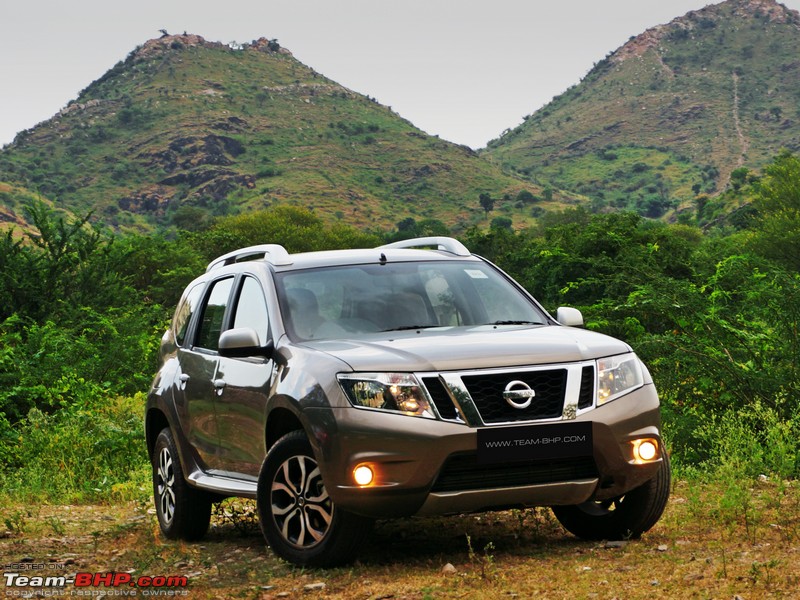 Last edited by GTO : 9th October 2013 at 20:12. |
| |  (40)
Thanks (40)
Thanks
 |
| The following 40 BHPians Thank n_aditya for this useful post: | 9thsphinx, alokgunhal, arsenal.arun, AutoIndian, bsdbsd, CARDEEP, chinmaypillay, darklord, dkaile, GTO, IronH4WK, JoseVijay, KarthikK, lurker, mroptimist, Nalin1, nkrishnap, nmc, prakasse, Rajain, Rehaan, rk_sans, roadjourno, RSR, S.MJet, scopriobharath, Sheel, SmartCat, speed kills, sri2012, suhaas307, swiftnfurious, theexperthand, ToroRosso, valapad, vb-saan, vibbs, VijayAnand1, virtualdanger, Yeldo |
| |
| | #2 |
| Senior - BHPian | Re: Nissan Terrano : Official Review The Nissan Terrano is mechanically identical to the Renault Duster. To read GTO's Duster Review, and to compare the two SUVs, click here.  Last edited by GTO : 9th October 2013 at 13:15. |
| |  (11)
Thanks (11)
Thanks
 |
| The following 11 BHPians Thank n_aditya for this useful post: | 9thsphinx, GTO, JoseVijay, KarthikK, moralfibre, Rehaan, RSR, surya_jindal, theexperthand, vb-saan, vibbs |
| | #3 |
| Senior - BHPian | Re: Nissan Terrano : Official Review  So far, we've seen Nissan's vehicles badge-engineered by Renault. This time however, the tide has turned. It's Nissan who is using a Renault product. The Japanese brand is cleverly rebadging the Duster to fill a void in its product portfolio. That said, the two companies claim this would be the last car shared between them. The Duster had quite a run in the early days where it enjoyed a first-mover advantage. With frequent price hikes & formidable competitors like the Ford EcoSport however, the Duster's volumes have recently taken a hit. This segment is expected to heat up further, with several manufacturers finalizing plans for an entry. The Maruti XA Alpha, Chevrolet Trax and Hyundai's yet unnamed small SUV will follow in the coming years. Last year saw sales of SUVs & MUVs (combined) overtake sedans for the first time ever. Our market's fascination with SUVs is well acknowledged; however, not everyone wants to drive a gargantuan SUV in crowded Indian cities. The time of compact SUVs has indeed arrived. With a monocoque construction (unlike the other ladder-on-frame utility vehicles), compact SUVs are lighter and, being sedan based, very car-like to drive as well. However, they aren't as tough as traditional ladder frame UVs, especially in load carrying or offroad applications. The monocoque UV seldom has a 3rd row of seats either (Ertiga being an exception). While commercial users will undoubtedly stick to conventional UVs, it's the personal user that the compact SUV has square in its sights. Cross-shopping across segments is commonplace in India, and target customers include those who are considering a premium hatchback or C segment sedan. The Terrano branding isn't new. Nissan has used the nameplate since the early 80s internationally. The Terrano / Duster is primarily sold as a Dacia product in other markets, most of which are developing countries. The Dacia brand is synonymous with low cost cars that have simple, robust underpinnings. The market has shown more than just a passing interest in this rebadged Duster. Apart from the headlamps and tail lights, Nissan has made sheet metal changes too. The Terrano is noticeably different to look at from the front & rear, and most people agree that it's the more handsome sibling. At the front, the Terrano wears a 3-part honeycomb grille with chrome slats. This grille wears resemblance to Nissan's global range of SUVs. A redesigned front bumper sans the black plastic section (at the lower end) adds to the appeal. The headlamp's twin barrels are smoked & boxier than the Duster's round pieces. The side profile has a bunch of subtle changes. Blackened pillars blend in with the window section nicely. The fiber black section (at either end of the running board) is now painted in body colour. The roof rails are full silver, instead of the Duster's silver-black combo. The Terrano isn't very tall; that's probably why the roof rails (which enhance its height) are standard. Look closely at the pictures and you'll see an additional crease on the doors. The rear sees a redesigned hatch and larger tail-lamps that extend to the boot lid. Must be said, the chrome garnish doesn't look as garish as on the Duster. The rear bumper gets a pair of reflectors and carries forward the silver accents of the Duster. If Nissan would've managed to mount the spare wheel on the boot, not only would the Terrano look like a 'proper SUV', but it would also have made it easier for owners facing a puncture. The wheels & tyres are simply massive. I'm glad that Nissan chose 215/65 R16 tyres just like Renault did for the Duster. This size offers superior grip and improves the Terrano's stance. On the flip side, going by the specs received from Nissan, the Terrano weighs a whopping 100 kilos more than the Duster! It's hard to understand where this bulk comes from. Needless to say, weight is inversely proportional to performance & efficiency. As good looking as the Terrano is, the small overall dimensions don't give this SUV the street cred of the Scorpio or better still, the Safari. In terms of footprint, I'd place the Terrano in the ballpark of the Skoda Yeti. The small footprint could work as an advantage or a disadvantage, depending which side of the fence you are on. As mentioned earlier, a large SUV can get unwieldy in dense traffic and is tougher to park in the city. Exterior build & quality are satisfactory for the most part. Unlike the interiors, there aren't too many visible signs of cost cutting (except for the cheap wipers and flap-type door handles). The paint quality is good, and the bonnet & tail-gate feel sufficiently solid. On the other hand, the doors feel hollow and have none of that satisfying thud. Still, overall quality is generations ahead of what the Mahindra & Tata UVs have to offer. Where the Scorpio & Safari are shoddily built and crude, the Terrano comes across as a more refined vehicle. This is an advantage that the urban owner will be particularly drawn to. The Terrano shares its platform with the Logan which has proven underpinnings. Hence, I'm reasonably assured that it will perform as a workhorse. After all, there are thousands of satisfied Logan taxi owners who have driven 200,000 kms (& counting) on their steeds. Caught in the act @ Kumbhalgarh Fort, Udaipur: 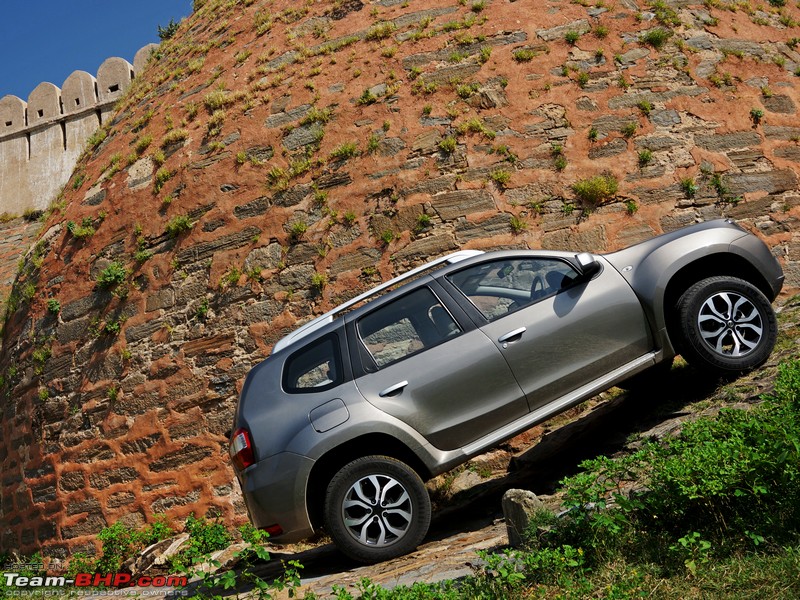 Rear end styling is noticeably different than the Duster's. Apart from the redesigned tail lamps, Nissan has also made sheet metal changes:  Side profile remains more or less the same. Blackened pillars, different alloys and the use of body coloured & silver paint (instead of black) differentiate it a little. Notice the extra crease on the doors: 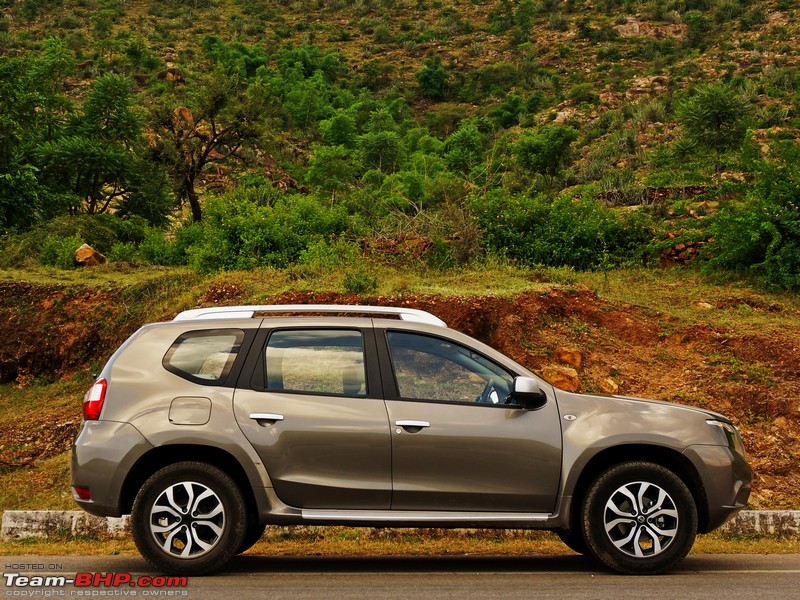    110PS to the left, 85PS on the right:  Softcore meets hardcore! Look at the smaller dimensions of the Nissan, even though it has more space than the Thar:  Smoked headlamps. Squarish design compared to the Duster. Turn indicators on top:  On the Terrano, the fog lamp housing is in body colour (as opposed to the Duster's black finish). Note the tow hook peeping out below:  Big Nissan insignia in the center of the honeycomb grille. Lots of chrome to appeal to Indian tastes:  Smooth crease lines of the bonnet blend in nicely with the front grille:  Cheap quality wipers. Body-coloured water drainage panel:  Beefed up wheel arches:  215/65 R16 MRF Wanderer Sport tyres. Diamond-cut alloys, as Nissan likes to call this finish:  Hub caps over steel rims for the lower variants: 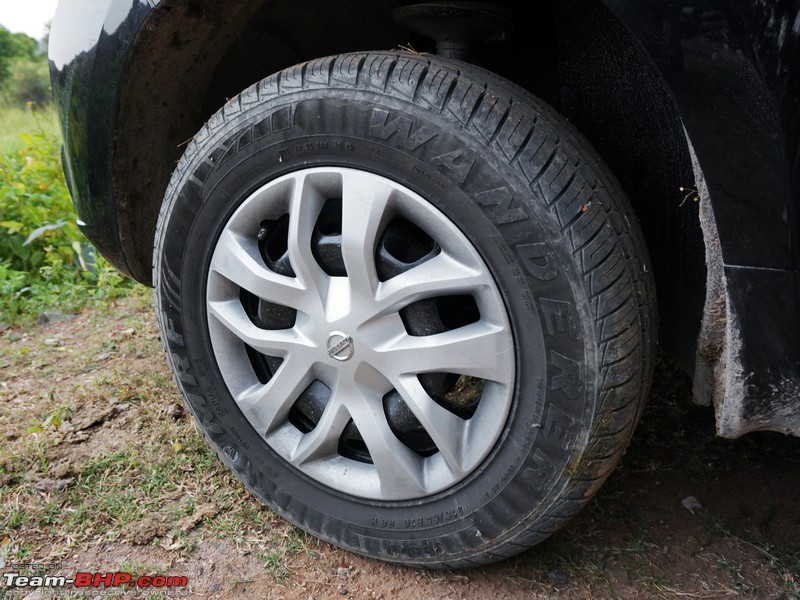 Cheap silver paint applied to the ORVMs. Should've been body coloured across all variants:  Door handles also wear the same cheap silver finish. Lower variants have it better (black handles): 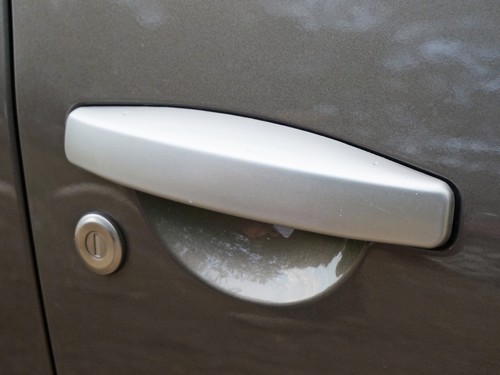 Roof racks are silver all through, unlike the Duster's black-silver combination:  Chrome garnish doesn't have cheesy vehicle branding over it (like the Duster):  Redesigned tail lamps:  Reflectors integrated into the rear bumper. Nicely recessed:  Quarter glass throws some extra light in. Notice the 12V power socket for the laptops & smartphones of rear passengers:  110PS gets a chrome exhaust tip...  ...while the petrol begs for one:  205mm of ground clearance ensures hassle-free driving over rough terrain: 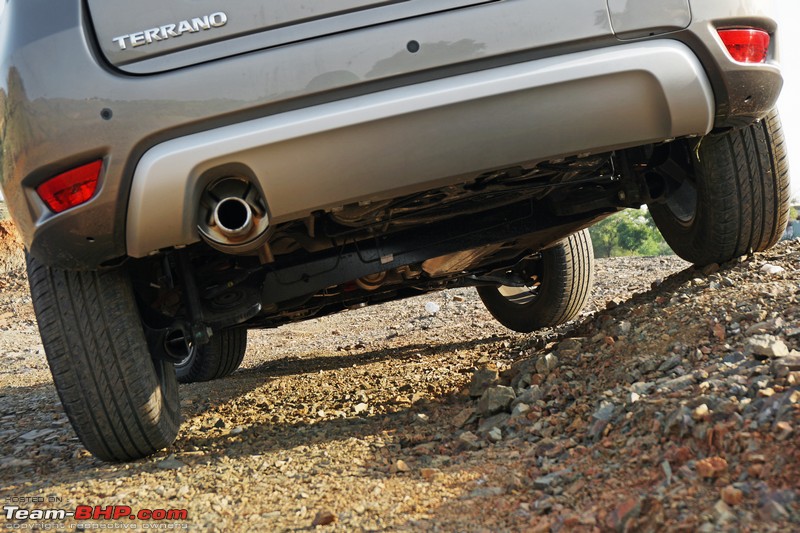 As we've seen on other Nissan cars, some panels remain misaligned. Here, the boot lid doesn't flow with the bumper design:  Uneven panel gaps on the rear tail lamps...  ...RHS gap is smaller than the LHS:  Last edited by Rehaan : 15th October 2013 at 10:48. |
| |  (31)
Thanks (31)
Thanks
 |
| The following 31 BHPians Thank n_aditya for this useful post: | 9thsphinx, AutoIndian, engrohit, ex670c, GTO, IronH4WK, JayKis, JoseVijay, karpusv, KarthikK, moralfibre, MYB, NPV, oli.ferns, pahwa, Rehaan, RSR, S.MJet, samabhi, Sheel, SmartCat, suhaas307, theexperthand, ToroRosso, uday.ere, valapad, vb-saan, vhharan1, VijayAnand1, VinodDevil81, virtualdanger |
| | #4 |
| Senior - BHPian | Re: Nissan Terrano : Official Review  Ingress is easier than in the lower slung sedans. The elderly will surely appreciate the higher placement of the Terrano's seats. However, egress from the back seat isn't as simple. The gap between the large rear seat & the B Pillar is limited, thus interfering with an effortless exit. Slide inside the Terrano and you'll immediately notice the bright, airy ambience. The large greenhouse allows a lot of sunlight in. In terms of look & feel, the interiors are all function and no form. The overall design is uninspiring; it's liveable, yes, but there is no “wow” factor at all. You'll be happy or unhappy with the interiors, depending on what class of vehicle you are comparing the Terrano to. Scorpio, Safari or Xylo? The Terrano blows them away. Interior quality is at least 2 levels superior to what the home-grown MUVs have to offer. The Terrano feels far more contemporary on the inside, while fit & finish are much superior too. On the other hand, if you are cross-shopping with equivalently priced sedans (like the Vento or Verna), the Terrano's interiors will fail miserably. There is an abundance of hard & shiny plastics here. None of the parts feel particularly worthy of a million rupee car; the quality is more in line with entry-level sedans than the likes of the Honda City. Unlike the exteriors, cost cutting is extremely obvious on the inside. For instance, the rubber beading wouldn't look out of place on a humble Maruti WagonR. The switchgear is economy-grade and the 7,000 rpm counter is common to the petrol & diesel variants. Look closely and you'll notice a lot of flimsy parts and panels with rough edges. It appears that the purchasing department exhausted its budget on the exteriors & mechanicals, and were left with little by the time they got inside. On the positive side, I found the colour combination to be very tasteful. The black & beige colour combination works, while the piano black, silver & chrome touches are thoughtfully applied. They play their part in improving the feel of the interiors. The Terrano even gets a few touches of faux wood on the door panels to liven things up. In full grey, this interior would have looked right out of the nineties (Logan memories are afresh). In summary, those who buy the entry & mid-variants will learn to live with it. However, customers spending big $$$ for the higher 110 PS Terranos will inevitably feel shortchanged. Space for front seat occupants is A+. The Terrano has reasonable width on the inside and the driver won't be elbowing his co-passenger much. Also, the glove box doesn’t interfere with the front passenger's knees. Headroom is just about enough, although it isn't excessive as in other SUVs. The 110 PS Terrano which was provided to us had factory installed leather seats and the quality of stitching was good. The front and rear seats were firm, yet offered a high level of comfort. The seats also provided decent lateral support thanks to their contoured sides. They could do with more prominent under-thigh support though. All 4 doors offer a comfortable place to rest your forearms on the move. That said, a center armrest for the driver is sorely missed, especially since the competing Scorpio offers a wonderful center armrest for the driver & co-passenger (each). The front seat's fore & aft adjustment range is long enough to accommodate the shorter as well as taller drivers. The driver's chair gets adjustable lumbar support as well. The setting is progressive and provides you with adequate lower back support. If you want to increase the seat height, you have to get off and pull on the bare metal lever (no plastic cladding). Of course, you can lower the height while being seated. It's a rudimentary procedure and just one of the many areas in which cost-cutting is obvious. On the bright side, the seat height adjustment has a good range. Short drivers will need this feature; even though the dashboard is placed on the lower side, the top of the instrument console will interfere with their line of sight. Frontal & lateral visibility are superb, and rearward view isn't too bad either. Whatever the reason may be, some folk will appreciate being able to "see the bonnet" while driving. The steering gets tilt adjustment only (reach is fixed). I could write a book on the messy ergonomics : Power window buttons are thankfully placed on the driver's door (remember the Logan's controls?), but the console on which they are fitted looks like an after-thought. Most of you will need to really stretch to access the buttons which are placed all the way at the front end of the door. The sharp edge of this console poked my right leg a bit too much whilst driving. In fact, Parrys had the same complaint about the window switch housing when sitting in the front passenger seat. The clutch, brake and accelerator pedals are awkwardly positioned, and are also too close to one another. There's no dead pedal...placing my left foot in the available space (to the left of the clutch) was tricky with large shoes. The ORVM adjustment knob is strangely located below the handbrake. Having been designed for left-hand-drive markets, the center console is angled slightly towards the passenger side. Thankfully, the central lock/unlock button has been moved closer to the driver (the Duster had it placed further away). Ergonomically, the Terrano still misses the mark by a mile. Try as I might, even after spending 2 days with the SUV, I just couldn't find my "ideal" driving position. Every hour or two, I'd fidget with some seat setting or the other. The Terrano is simply not as user-friendly as the typical Japanese or Korean car. In fact, the only other car in which the ideal driving position remains so elusive is the Fiat Linea. Even though the Terrano is built on the Logan’s platform, it doesn't offer the rear legroom of its sedan sibling. To put things in perspective, legroom is similar to a Hyundai i20 rather than the Honda City. I'd term it as strictly adequate; it's not what I would call spacious, but neither is it too cramped. The back of the front seat is scooped in to liberate that much more knee room for rear passengers. Where the rear bench scores is in support & sheer width. The seat back is superbly reclined, making the bench a comfortable place to relax on. Also, the center armrest is great to use. The rear seat is positioned noticeably higher than the front; this, combined with the large windows, makes for a bright ambience. It's not claustrophobic at the back at all. The rear seat is wide enough to easily accommodate 3 passengers. The India-specific rear air conditioner looks like an after-market fitment though. It's placed too close for comfort to the rear seat. The 5th passenger will have to twist & turn his legs before being able to sit in the middle. That said, he won't have any problem once he is seated (contrary to popular perception). I sat as the 5th passenger for a couple of kms and didn't have any complaints. The 5th passenger's seatback - which is the base of the center armrest - is soft and provides adequate cushioning. The rear air-conditioner has its own condenser, unlike the Nissan Sunny's meagre air blower. Do note that speed II is pretty noisy. You might want to switch back to speed I after the desired temperature has been reached. The planted ride quality improves overall comfort levels for rear passengers. The body roll is well in control and I'd much rather be seated on the backseat of a Terrano than a shaky Xylo. The single fly in the ointment is the limited legroom, something Renault could have easily solved by equipping the Terrano with a sliding rear seat. Such small additions make the difference between an "average" and "intelligently" packaged interior. After all, what do you use more? The rear seat or the boot? Why not leave it up to the owner to decide? A number of market successes have proven that Indian customers prioritise rear seat space over luggage capacity. At the very least, the rear seat should have been positioned further back to release more legroom for passengers. Our test-drive was in Rajasthan with the temperature hovering around 32-34 degrees Celsius. I found the cooling of the air-conditioner to be strictly average in these conditions. Even with the fan speed at level 4, the interiors were only cool (not cold). Another irritant was that I could never get the air directed satisfactorily to my face, despite adjusting the vents several times. The Terrano is equipped with a double-DIN music player which allows for Bluetooth, USB, Aux and CD inputs. You can pair your phone for hands-free voice calls as well. One gripe we had was that every time we plugged in the GPS system (to charge via USB), the bluetooth connection with my phone would end, forcing us to manually connect the device again. On the plus side, the HU sports a 'Night / Day' function which allows the driver to dim the display with a simple press of a dedicated button. Sound quality is decent and delivered via a 4 speaker system. However, if you care about audio quality, upgrading the speakers is a must. A 6.1" touchscreen head-unit with navigation is available as an official accessory, and so is the steering audio controls module. There is a fair amount of storage space at the front. The glovebox runs deep and is illuminated. The door pockets are deep as well, and can hold 1 liter bottles. Be warned that the mouth (of the door pockets) is quite narrow and the rough edges can scratch your hand. There are 2 small cup / can holders right ahead of the gear lever. The dashboard has accommodating storage cubicles above the center air-vents and the glovebox. I found the cubicle below the handbrake perfect to park my smartphone. It also has borders that ensure your phone doesn't slide out under hard cornering. Rear passengers don't get door pockets, although there are two seat-back pockets (on the front seats). The 475 liter boot has a practical layout and the loading lip isn't too high either. The twin-tray parcel shelf can hold knick knacks in place. The parcel shelf will also come in handy to hide shopping bags from prying eyes. I am at a loss for words as to why the folding rear seat doesn't have a 60:40 split option. This greatly limits cargo flexibility. My unscientific opinion is that a split seat would be used a lot more in lifestyle SUVs than hatchbacks or sedans. The wheel is uniform with no contours or indents for your thumbs. It's not chunky or meaty enough to hold. Unlike the Duster, no audio controls behind the steering wheel:  No redline marking on the simple rev counter (common to petrol & diesel). Flashing turn indicators are too dim to be visible in bright daylight:  MID has all the necessary information. Shown here are average speed, fuel efficiency, distance to empty and, uniquely, the liters consumed so far: 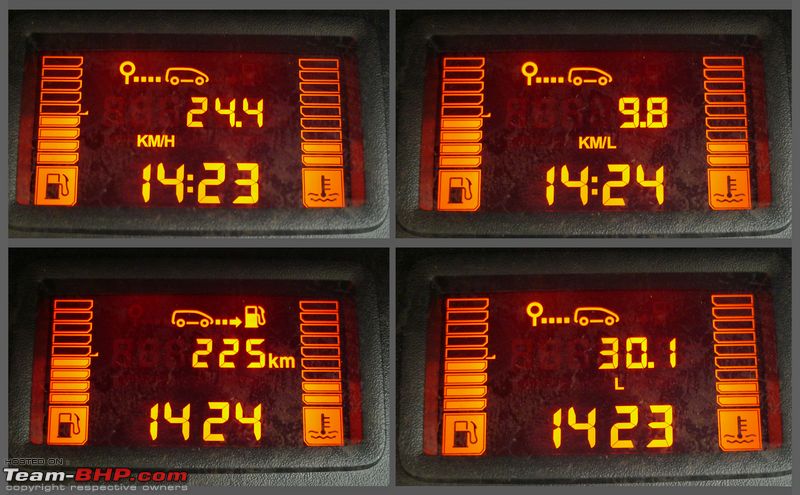 Budget quality control stalks. Light control stalk is to the left, wipers to the right:  Piano black center console with silver garnish on the sides:  2DIN head-unit with 4 speakers. CD, USB, AUX & Bluetooth compatibility. Sound quality is typically OEM grade. A useful 'day/night' button (top left) to toggle the brightness level: 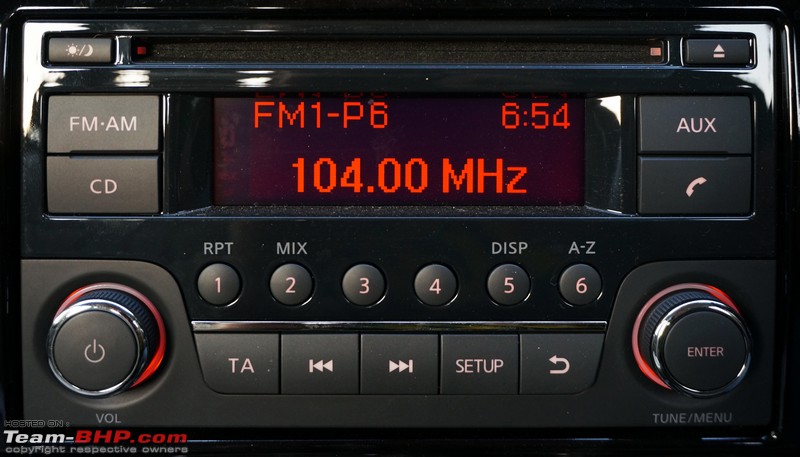 USB & AUX ports are located right below the head-unit:  No climate control offered on any variant. Recirculation slider control sticks out like a sore thumb:  Terrano 110 gets a 6-speed transmission. Shift quality is light enough and sure slotting, although it has a rubbery side to it. Lift the collar to engage reverse:  No dead pedal. Clutch & brake pedals are too close to each other. Terrano gets beige carpets. The Duster's black carpeting is more practical for Indian use:  The Duster had most of its interior trim in black. The Terrano makes the interiors more airy with beige panels. The application of faux wood looks good:  The extremely useful "one-touch down" function is missing, even for the driver's window: 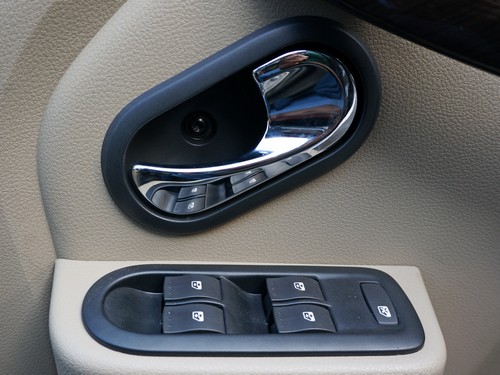 Good lumbar support, but the bare-metal seat height adjustment lever is crude to look at and rudimentary to use. On the positive side, it has a good adjustment range: 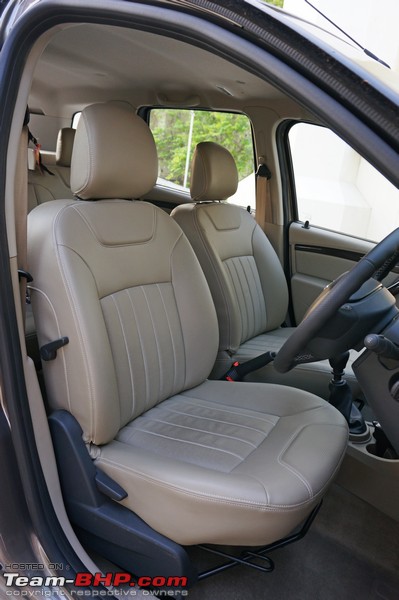 ORVM adjustment knob is oddly placed below the handbrake:  In case you're wondering; the A/C blower housing (for rear passengers) can in no way act as a driver armrest:  Storage bin on top of the dashboard has a lid. Good place to store those toll slips: 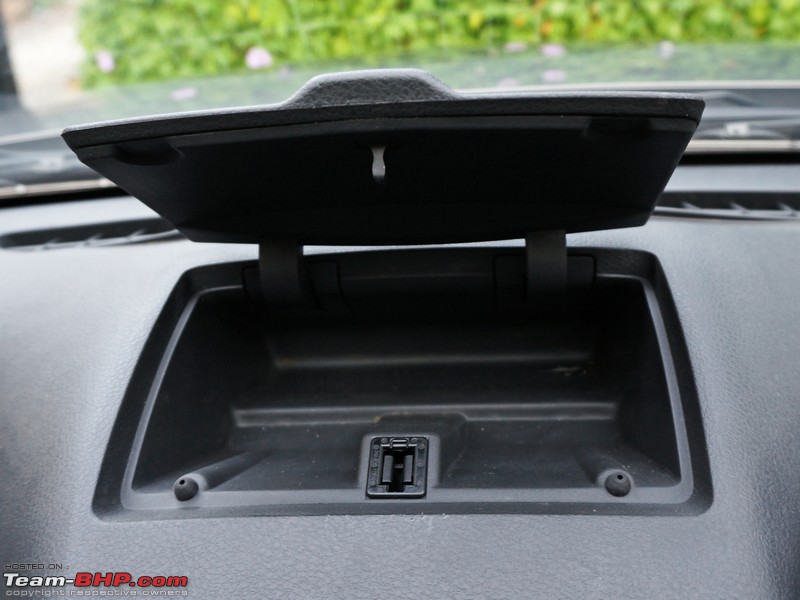 Chrome surround on the A/C vents looks nice:  Two cup-holders ahead of the gear lever. A removable ashtray is part of standard equipment. The button with the red light illuminated indicates that the reverse parking sensors are off:  Illuminated glovebox runs fairly deep. Notice the dedicated partition for the owner's manual:  Even though both wing mirrors are the convex-type, we found them to be a size too small for an SUV. Their height is satisfactory, it's the width that we were unhappy with:  Inside mirror is sufficiently wide:  Rearward view for the driver. Be sure to give the ORVMs a glance before reversing, as the thick D-Pillars create blind spots. Also visible in this picture is the 5th passenger's fixed neck restraint:  Easy ingress. Doors don't get any rubber beading. Beading is there on the inside body frame though:  Mediocre legroom for rear passengers. Seat offers superb support while the backrest is nicely reclined for comfort: 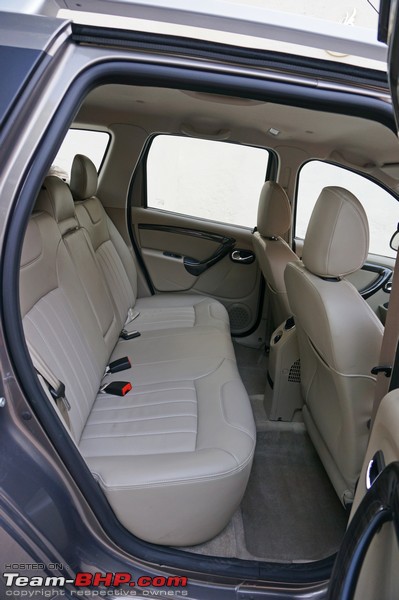 A look at the minimum & maximum available legroom for rear passengers:  Rear bench gets a center armrest with 2 integrated cup holders:  Rear air-con tower looks like an after-market fitment. Unlike the Nissan Sunny, this is a proper air-conditioning unit and not merely a blower fan. The elastic strap at the bottom can be used to hold a small water bottle:  A picture showing just how much the rear air-con tower juts out. You can also see the floor hump here:  475 liter boot has a practical layout with the tail-gate opening upwards (like a hatchback), rather than hinging to the side:  Last edited by GTO : 11th October 2013 at 10:36. |
| |  (25)
Thanks (25)
Thanks
 |
| The following 25 BHPians Thank n_aditya for this useful post: | 9thsphinx, AutoIndian, GTO, john doe, JoseVijay, KarthikK, KPS, lurker, Mighty_Lothar, moralfibre, Rehaan, RSR, S.MJet, samabhi, scopriobharath, SmartCat, sri2012, suhaas307, swiftnfurious, theexperthand, valapad, vb-saan, vhharan1, VijayAnand1, virtualdanger |
| | #5 |
| Senior - BHPian | Re: Nissan Terrano : Official Review  The Nissan Terrano has three engine options; two 1.5L diesels and one 1.6L petrol. Both the diesel variants have the same engine, albeit running in different states of tune. The 84 BHP 1.5L engine has a fixed geometry turbo, while the higher powered 109 BHP diesel gets a variable geometry unit (Nissan calls it the Variable Nozzle Turbine). This K9K turbo-charged common-rail diesel is the runner-up for the National Engine of India title (currently bestowed to the Fiat 1.3L MJD), due to the large number of vehicles running this engine. The K9K powers the Logan, Sunny & Fluence sedans, the Micra & Pulse hatchbacks, the Evalia MUV and the Duster & Terrano SUVs. This SOHC 8 valve powerplant is old-school...it's nowhere as contemporary as the Fiat 1.3L DOHC 16v MJD that powers so many Indian cars today. Nevertheless, the K9K is an acknowledged workhorse known for its durability and high fuel economy. 109 BHP Diesel Engine:  The Terrano's 110 PS engine makes 109 BHP (@ 3,900 rpm) and 248 Nm of max torque (@ 2,250 rpm), with an ARAI fuel efficiency rating of 19.0 kpl. There is hardly any clatter noticeable on the outside. At idling, it isn't easy to identify as a diesel engine! Nissan has put in quite a bit of effort on the Terrano's NVH and it shows. Even at higher rpms, the Terrano is noticeably quieter than the Renault Duster. It's sufficiently smooth and at cruising speeds, passengers won't even know there is a diesel under the hood. However, wind noise is terribly prominent. There is a bad amount of turbo-lag below 2,000 rpm, and the 109 BHP Terrano only gets punchy above 2,200 rpm. The lag won't bother you much when starting off from a standstill, thanks to the short 1st gear ratio. However, it can seriously catch you out if you try to drive around town at low speeds in 2nd gear, or on inclines. The only solution is to downshift and get that engine into the turbo zone. I had to make frequent downshifts in slow moving traffic that was reminiscent of urban rush-hour traffic conditions. It does take a couple of kms to get used to the lag and learn to drive around it. I wouldn't consider the lag a deal breaker, although the 84 BHP Terrano offers far superior driveability in town. The 110 PS' turbo is unforgiving and you have to pay attention to choosing the right gear at lower speeds. In comparison, the 84 BHP Terrano lets you get away with a less attentive style of driving. Keep the engine on the boil and the 109 BHP Terrano will reward you with brisk performance on the open road. You need to hold the steering firmly as torque steer does set in under hard acceleration. When the turbo kicks in, you feel a mild boost and the engine accelerates clean thereafter. 3rd gear was a vital tool on single lane highways, and overtaking other vehicles was effortless due to the punchy mid-range power delivery. This 1.5L diesel feels best between 2,300 - 4,000 rpm, after which there isn't much progress. The engine will revv to 5,000 rpm when required, but you'll do well by upshifting at 4,000 rpm tops. The Terrano 110 gets a 6-speed manual gearbox that makes for relaxed expressway cruising. 100 kph in 6th gear sees the engine spinning over at 2,200 rpm and right in the turbo zone. The gearbox's throw is longer than I prefer, while shift quality does have a rubbery side to it. The box has well-defined gates though and is eager to slot; not once did we mis-shift while driving. Surprisingly, the clutch on the 110 PS Terrano felt lighter than that of the 110 PS Renault Duster. It isn't too heavy, but not what I'd call a light, effortless pedal either. As the Terrano & Duster have the same mechanical bits, there is a possibility that the Duster 110 has also gotten a slightly lighter clutch now (compared to the early example that GTO drove in his Official Review). As mentioned earlier, the engine's NVH levels are outstanding. In your daily drive with the windows up and the air-conditioner running, you will barely hear the diesel engine. However, wind noise is terribly prominent. At high speeds, you can hear significant wind turbulence. 84 BHP Diesel Engine: Representative image from GTO's Duster Review: The Terrano 85 variant churns out 84 BHP (@ 3,750 rpm) and 200 Nm of max torque (@ 1,900 rpm). It runs nearly the same tune as the Sunny / Scala versions of this engine. The two main differences are that the Terrano makes 1 BHP less and max torque at a 100 rpm lower than the sedans. Compared to the more expensive 110 variant, the Terrano 85 has 25 BHP & 48 Nm of torque less. Is the Terrano 85 underpowered then? Not at all. Its power / weight and torque / weight ratios are still superior to the Scorpio, Safari and Innova – thanks to a lighter kerb weight. Further, the power / weight ratios are about the same as the Maruti Ertiga, and within 10% of the more expensive Mahindra XUV500 and Skoda Yeti. As expected, the Terrano 85’s USP is the outstanding in-city driveability on tap. Turbo lag is too negligible to mention, with the engine feeling immensely tractable. While the Terrano 110 only really wakes up after 2,000 – 2,200 rpm, the Terrano 85 pulls clean from as low as 1,200 rpm. The engine behaves like a naturally-aspirated diesel! Translated, you’ll seldom need to downshift within the city. The Terrano 85 passes the 2nd gear speed-breaker test with flying colours; it is even possible to drive away from 0 kph in 2nd gear, with just a little clutch slipping. We didn’t face any problem in climbing flyovers in 5th gear itself. In traffic conditions that the Terrano 110 would require frequent downshifts, the 85 happily rolls along in the same gear. You can use the versatile 2nd or 3rd gear (choice dependent on traffic speed) just like an automatic. With liberal usage of the accelerator pedal, the Terrano 85 is reasonably peppy in the city. That said, it somehow doesn’t sprint as fast as the Sunny / Scala Diesels. Power delivery is fairly linear, but the 110’s mid-range punch (and initial torque steer) is missing. The 110’s highway performance is noticeably superior. With the 110, you have a decent amount of reserve power in most highway conditions; this isn’t the case with the 85. Don’t get me wrong, the Terrano 85 isn’t under-powered. Performance is completely satisfactory up to 120 – 130 kph, only after which power delivery starts tapering off. The engine doesn’t enjoy spinning over 4,000 rpm either. Since the motor runs out of breath sooner, the 85 is best suited to a sedate driving style on the expressway...the same conditions where its more powerful sibling runs like a horse. Anything that the 85 does on the open road, the 110 does better (as long as the needle is hovering over 2,000 rpm). With a full load of 5 occupants and luggage onboard, the difference between the two will be even more noticeable. The Terrano 85 gets a 5 speed gearbox (unlike the 110’s 6 speed) and therefore, 100 kph cruising comes at a higher 2,400 rpm. On tight & twisty ghat sections, there isn’t a doubt that the Terrano 85 will perform better, simply because you don’t have to contend with turbo lag. Just like the 110, the 85’s clutch also requires a certain amount of effort to operate. It seems to have a slightly shorter throw and isn't as aggressive as that of the 110. Nevertheless, the 85’s clutch isn’t a light & easy clutch either. The 85's gearshift quality is not as rubbery as that of the 110, but it's fairly notchy. Don't expect the slickness and smoothness of Japanese gearboxes here. It does the job and that's all. I found the Terrano 85’s engine NVH levels to be excellent. That said, just like the 110, wind noise is annoyingly prominent at 80 – 100 kph. Overall, if there is any difference from the 110 variant in terms of NVH, it's not much. As a result of having lesser power though, the 85 has to work harder (higher rpm) than the 110 on the highway and thus sounds louder in the same situations. Overall, does the Terrano 85 do the job? You bet. Power delivery is adequate, even if it lacks the muscle of the 110. If you drive primarily within a congested Indian city, the 85 is the more sensible choice. It’s cheaper and more fuel efficient too! 103 BHP Petrol Engine:  Petrol variant is available only in the XL variant:  The petrol Terrano is powered by a 1598cc naturally-aspirated motor producing peak power of 103 BHP (@ 5,850 rpm) and max torque of 145 Nm (@ 3,750 rpm). You might assume that this engine is also a straight lift from the Sunny / Scala. Nope, the sedans are powered by slightly smaller 1.5L engines. Petrol SUVs have traditionally done poorly in India and we can safely assume that the Terrano petrol will make up for a small % of sales. The 1.6L engine doesn't excel in any particular area; it ranks middle-of-the-way on most parameters. The petrol Terrano is no street scorcher, but it is definitely not under-powered either. The sedan-like kerb weight, coupled with 103 horses, ensures that performance is acceptable. Urban driveability is similar to other petrol sedans, though it certainly doesn't have the torque delivery of the 85 diesel. If you are patient, the Terrano petrol will amble along just fine in the city. If you're in a hurry, downshifting is a frequent occurrence as the motor doesn't feel particularly punchy below 2,000 rpm. Above 2,000 rpm, the Terrano petrol has decent punch. Power comes in a straight, linear manner. Open road performance is reasonable by SUV standards. Keep the accelerator pinned and the rpm needle will climb to ~6,300 rpm. It doesn't like high rpms though, and starts getting gruff near the redline. The petrol is best suited to a sedate driving style, an aggressive driver will notice more noise than (actual) progress. The Terrano petrol does 80 kph @ 2,500 rpm in 5th gear and 100 kph @ 3,000 rpm. The car is comfortable doing speeds up to 120 kph. Beyond that, wind & engine noise make it less enjoyable. The petrol's clutch pedal is lighter than that of the diesel, always a good thing. On the other hand, the gearbox is notchy and the gates aren't well-defined either. The Terrano petrol will only appeal to those who are on a tight budget or have very low running. There isn't a doubt that the diesels are the pick with this Nissan. Ride, Handling & Braking: Nissan has hit the sweet spot with the suspension's ride & handling balance. The ride quality, in one word, is outstanding. The Terrano flattens bad roads like few cars costing <35 lakhs do. The same stretch of broken tarmac that feels bumpy in an Innova is dismissed off with arrogance by the Terrano. Yes, there is a certain amount of stiffness felt, but its well within acceptable limits. You won't even feel the need to slow down for a bad road, especially at speed. What's more, on the highway, the suspension rides flat. There is none of the rear end bounciness that most competing SUVs suffer from. The dampers & springs are extremely well-tuned & the suspension travel over broken roads is impressive. Another strength of this suspension is that it doesn't make a noise when doing its work. There are no unnecessary clunks & thuds heard on the inside. Unlike most competing SUVs & MUVs from this price range, the Nissan Terrano has a front-wheel-drive (FWD) layout. This, along with the monocoque body construction, makes the Terrano very car-like to drive. The turning radius is merely 5.2 meters (smaller than that of the VW Vento), making it easy to handle within the city. At expressway speeds, the Terrano's behaviour is safe & predictable. Body roll is well controlled under all driving conditions. A sedan driver doesn't have to go through a learning curve when driving a Terrano for the first time, unlike the Safari & Scorpio that entail a change in your high speed driving style. Yes, there is some top heaviness felt at 100 kph, but it's within acceptable limits. Pushing into a fast corner will see the Terrano settle into gradual understeer; but it is progressive and there are no nasty surprises. Straight line stability is par for the course. It isn't exceptional and you do need to keep a firm hand on the steering wheel, but at no time does the Terrano feel nervous. I haven't a doubt that the Terrano will manage a highway emergency manouveur in a far superior & safer manner than the domestic UVs. One gripe I have in the handling department is the steering wheel. For the most part, it is well-weighted (even if it requires extra effort at parking speeds). However, the steering's center-back action is simply too aggressive. On fast turns, the steering provided a lot of resistance and interfered with the smooth inputs that I was trying to dial in. Over quick ghat sections, you literally have to fight with the steering at times. Leave aside enthusiasts, the lay man will hate this behaviour the most. I give the Terrano's brakes an above average rating. The brake pedal feels spongy at speed and isn't the easiest to modulate. The Terrano stops without a fuss, and capability is far better than the Tatas & Mahindras, but the C2 & D1 segment sedans are in a different league altogether. I was pleased with the fact that the Terrano maintained its composure in an emergency braking situation. There wasn't any nosedive under braking either. I've never been much of an MRF Tyres fan, yet I'll give it to them for the Wanderer Tyres of our Terrano. They provided good levels of grip, even with a heavy right foot, leaving me pleasantly surprised. Indeed, this is excellent rubber by OEM tyre standards. 205mm of ground clearance and a shorter wheelbase ensure that the underbelly doesn't scrape anywhere. Do keep in mind that the MRF tyres are made strictly for tarmac. They lose grip easily on the likes of mud & grass. As the Terrano is a 2WD, you shouldn't attempt anything remotely close to off-roading with it. The cladding might seem minimal, yet engine noise levels are brilliantly controlled:  Bonnet has a hydraulic strut. All you have to do is unlock the bonnet and the strut will do the work of lifting it up:  Turbo plumbing. Smooth curves and even welds on the joints:  Nissan diesel badging under the variant nomenclature:  Big fuel flap is unusually wide. Looks ungainly:  Last edited by Rehaan : 15th October 2013 at 11:19. |
| |  (21)
Thanks (21)
Thanks
 |
| The following 21 BHPians Thank n_aditya for this useful post: | 9thsphinx, GTO, IronH4WK, JoseVijay, KarthikK, Mighty_Lothar, moralfibre, Rehaan, RSR, scopriobharath, Sheel, SmartCat, suhaas307, swiftnfurious, theexperthand, thoma, valapad, vb-saan, vhharan1, VijayAnand1, virtualdanger |
| | #6 |
| Senior - BHPian | Re: Nissan Terrano : Official Review Other Points: • Even if Nissan wanted to, they couldn't price the Terrano lower than the Duster. Renault & Nissan have an understanding that, whoever uses the other's car has to price it higher. • At the time of launch, this Nissan has already garnered 6,000 pre-bookings. • Standard warranty of 24 months / 50,000 kms. Extended warranty for 4 years / 80,000 kms (total coverage) available. • Driver airbag standard across all variants! Good move. • Here's the official Accessories brochure : Terrano Accessories.pdf • Not confidence inspiring : The Duster (aka Terrano) received only 3 out of 5 stars in the Euro NCAP tests. Link to results. • The Terrano has a meek single-unit horn. A powerful dual-tone unit would have been preferred. • The 2nd generation of this B platform is used in cars like the Nissan Micra, Sunny etc. • Only the export Duster is equipped with a diesel particulate filter (for lower emissions). The Indian Terrano / Duster meet Indian pollution norms without a DPF. • The Nissan Terrano is an India-specific rebadging exercise. No export plans on the radar. • Doors don't auto-lock once you start driving. Good news is, it's possible to activate this feature yourself (refer to the owner's manual). • ARAI ratings : 13.2 kpl (1.6L Petrol), 20.5 kpl (1.5L Diesel 85 PS) and 19 kpl (1.5L Diesel 110 PS). The Terrano has a 50 liter fuel tank capacity. • The control stalks remain inverted for European use (indicators on the left, wipers on the right). • Reverse parking assistance has audible feedback only. No visual display. • If you have long arms, the rear air-con unit could interfere with your left hand while changing gears. • The rear air-con functions independently of the front. Remember to switch it off (separately) when not needed. • Thanks to the light weight & compact dimensions, a Terrano with 4x4 and A/T tyres would be capable enough to keep 98% of the aam junta satisfied. • The turning indicators make a beeping sound like a motorcycle, rather than a clicking indicator sound that most other cars make. • Driving through narrow gaps or densely trafficked areas, account for the bulging wheel arches when calculating the gap. • Thanks to Stratos for post-processing the pictures, and to Ampere for providing a test-drive of his Duster. This greatly helped in a real-world comparison between the two vehicles. • Disclaimer : Nissan invited Team-BHP for the Terrano test-drive. They covered all the expenses for this driving event. Last edited by GTO : 2nd December 2013 at 14:08. Reason: It's possible to activate the auto-locking door mechanism yourself. |
| |  (23)
Thanks (23)
Thanks
 |
| The following 23 BHPians Thank n_aditya for this useful post: | arsenal.arun, darklord, devilwearsprada, ex670c, GTO, heatednemz, IronH4WK, JoseVijay, KarthikK, KPS, kutts, moralfibre, Rehaan, RSR, scopriobharath, Sheel, suhaas307, supremoo, swiftnfurious, theexperthand, vb-saan, vhharan1, virtualdanger |
| | #7 |
| Senior - BHPian | Re: Nissan Terrano : Official Review The Smaller yet Significant Things: Excellent cargo carrying ability (1,064 liters) with the rear seat folded down:  Boot lamp will help you find your stuff at night:  Under-body mounting for the spare. While our test car was equipped with an alloy wheel spare, customer cars aren't:  Rear air-con tower has a nifty strap to secure bottles / other items:  Similar strap on the passenger side of the front footwell:  3-point map lights at the front:  Rear cabin lamps are conveniently placed. There are two of them (one on either side), they can be set to activate on door-open:  Bonnet release lever uses the same design as the fuel flap lever. However, it has no markings:  Storage bin above the glovebox is nicely recessed to hold oddities in place:  Passenger sunvisor gets a vanity mirror, driver's side doesn’t: 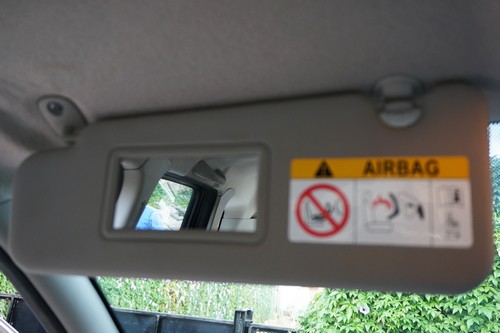 Seat-belts get height adjustment:  Triple-level headlamp beam height adjustment is placed far too low, near the driver's right knee:  Lower variants (sans the rear air-con) get an extra cup / bottle holder:  Deep door pockets are equipped with bottle holders:  Another look at the uneven panel gaps. Bumper is tight towards the side of the car, albeit the gap widens near the headlamp:  Flimsy fit & finish. I could lift this beige layer off the dashboard with my finger!!  Ill-fitted cup holder on the rear armrest. This could've been properly screwed in, instead of being merely placed (or poorly glued?) inside:  Neat piping over cables running into the doors:  Power window unit left me with a sore knee. Same applies for the driver's side:  The lower variant's beige fabric seats:  Loops inside the boot to tie luggage down:  Storage pockets behind both front seats: 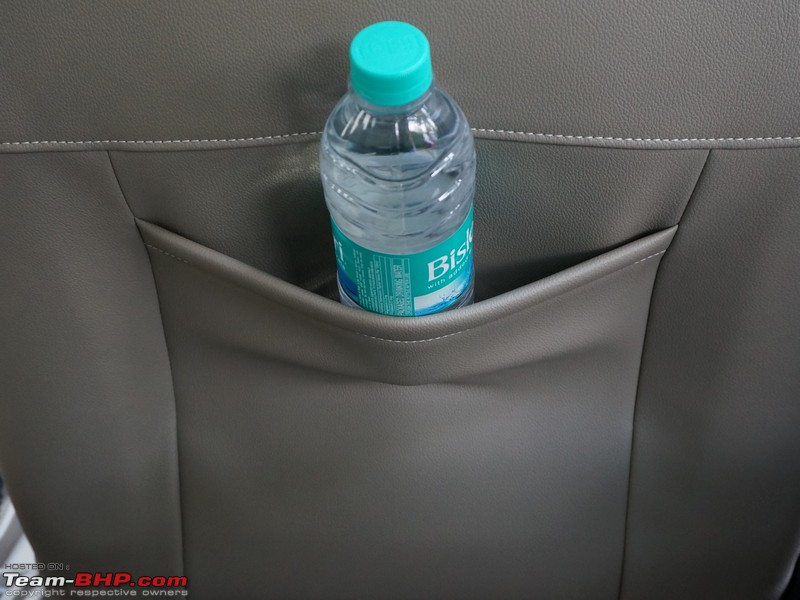 Rear windows don't roll completely down: 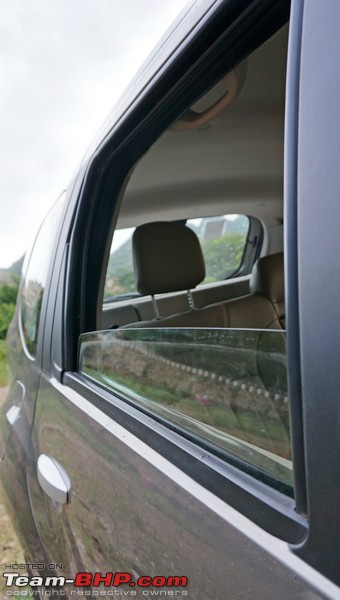 The twin-tray parcel shelf can hold knick knacks in place. Also useful to hide valuable items in the boot from prying eyes:  Jack & other tools are housed in a side compartment in the boot:  No coat hooks on any of the grab handles:  Simple key with door lock & unlock buttons. Unlocking the doors also unlocks the boot: 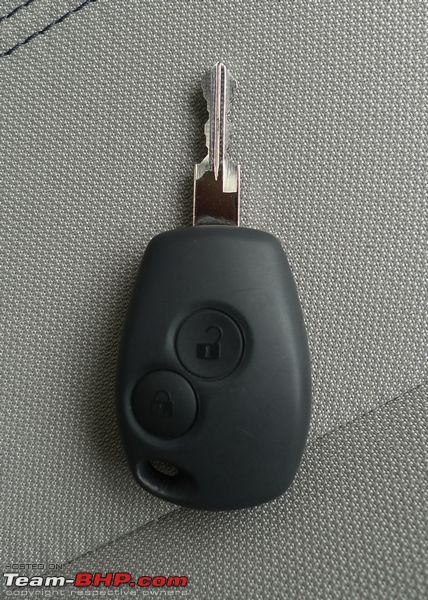 OBD Port is located inside the glovebox (pic from GTO's review): 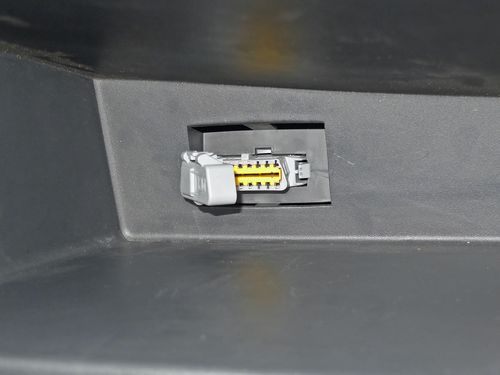 Nissan is offering a jump seat (placed in the boot area) as an official accessory. It's a side-facing, foldable unit. I personally think it's a terrible idea! Firstly, there is no provision for a seatbelt. Secondly, I'm pretty sure that the RTO will frown upon adding more seating to the Terrano at the dealer level:  Last edited by GTO : 10th October 2013 at 20:03. Reason: Adding pic of jump seat |
| |  (19)
Thanks (19)
Thanks
 |
| The following 19 BHPians Thank n_aditya for this useful post: | amoi, darklord, dkaile, GTO, IronH4WK, JoseVijay, KarthikK, moralfibre, Rehaan, RSR, scopriobharath, Sheel, suhaas307, swiftnfurious, theexperthand, timuseravan, valapad, vb-saan, vhharan1 |
| | #8 |
| Senior - BHPian | Last edited by GTO : 10th October 2013 at 15:13. |
| |  (29)
Thanks (29)
Thanks
 |
| The following 29 BHPians Thank n_aditya for this useful post: | 9thsphinx, anToNIcHeN, Batfreak, F150, girishglg, GTO, InControl, IronH4WK, john doe, JoseVijay, KarthikK, KPS, Latheesh, Maky, moralfibre, phamilyman, Rehaan, RSR, scopriobharath, Sheel, sri2012, suhaas307, swiftnfurious, theexperthand, thoma, ToroRosso, valapad, vb-saan, vhharan1 |
| | #9 |
| Team-BHP Support  | Re: Nissan Terrano : Official Review Thread moved from the Assembly Line to Official Reviews. Thanks for sharing! *Rates thread a well-deserved 5 stars* |
| |  ()
Thanks ()
Thanks
 |
| | #10 |
| Team-BHP Support  Join Date: Feb 2004 Location: Bombay
Posts: 24,023
Thanked: 34,033 Times
| Re: Nissan Terrano : Official Review Nissan Terrano vs Renault Duster : A back-to-back visual comparo. FRONT The Terrano bumpers are completely body coloured, whereas the Duster's bumpers have the bottom half in black   HEADLIGHT   REAR Terrano's rear chrome strip stays clean, the Renault gets a massive "DUSTER" embossed on it   TAILLIGHTS   WHEELS  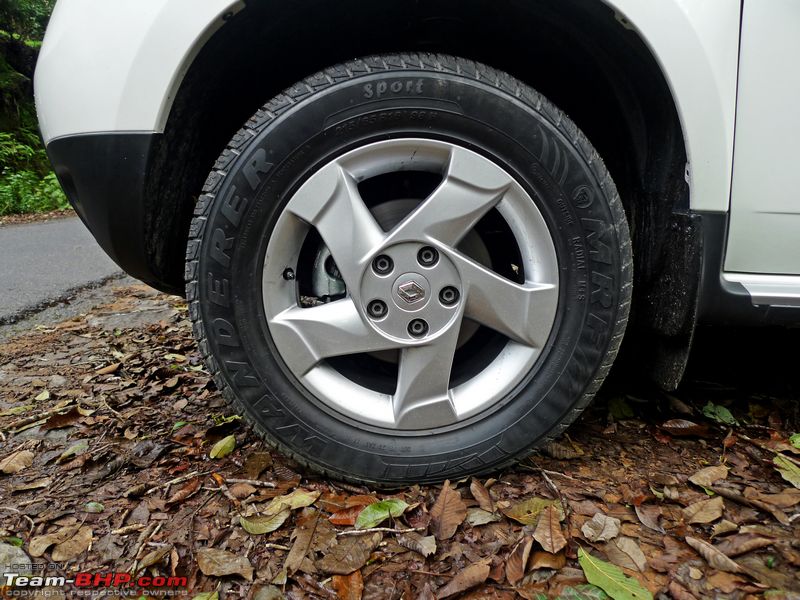 STEERING WHEEL The Terrano gets a driver's airbag across the range, the lower Duster variants come without airbags   Bonus: Only the Duster gets steering mounted audio controls. The Terrano doesn't get `em.  DASHBOARD Differently shaped center A/C vents, minor changes on the center console   AUDIO SYSTEM / CENTER CONSOLE Terrano gets day/night mode + USB and Aux are mounted away from the HU   DOOR PANEL In addition to the piano-black, the Duster also has the option of a browner faux wood finish  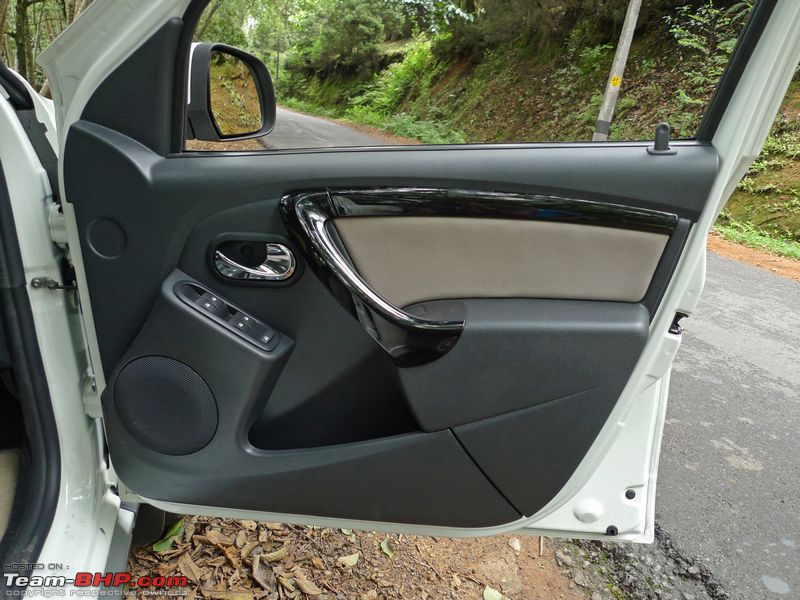 DASH-TOP STORAGE BIN Terrano gets a lid  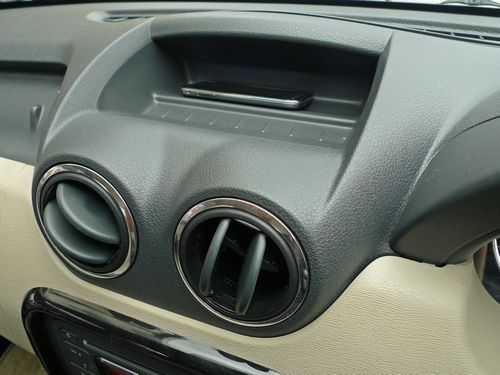 REAR A/C BLOWER Note the different vent adjustment designs  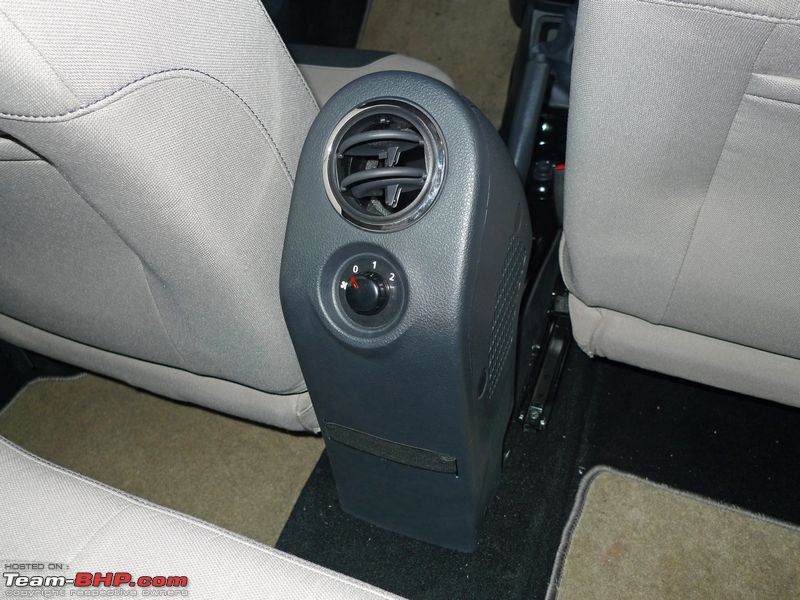 Last edited by Rehaan : 9th October 2013 at 15:40. |
| |  (29)
Thanks (29)
Thanks
 |
| The following 29 BHPians Thank Rehaan for this useful post: | anjan_c2007, arsenal.arun, basilmabraham, Blueleader, GTO, InControl, IronH4WK, JayD, jeetaman, JoseVijay, KarthikK, KPS, Latheesh, Maky, moralfibre, niv26, Prodigy07, RSR, scopriobharath, Sheel, sri2012, swiftnfurious, theexperthand, valapad, vb-saan, Vid6639, vinod1976, virtualdanger, W.A.G.7 |
| | #11 |
| BHPian | Re: Nissan Terrano : Official Review Wonderful review. Covers all aspects that anyone looking at Terrano, other options, comparison with Duster etc... 5 Stars. Thanks a lot for the excellent review. The car doesnt really excite as much as the review does..  Last edited by basilmabraham : 9th October 2013 at 15:17. |
| |  ()
Thanks ()
Thanks
 |
| |
| | #12 |
| BHPian Join Date: Jun 2011 Location: Ktym
Posts: 432
Thanked: 457 Times
| Re: Nissan Terrano : Official Review Another blown up Dacia pushed down the throat of unsuspecting customers branded as a Japanese vehicle and demanding a price as if its a direct import from Japan.  No doubt it would sell on account of the tough engine and the awesome mileage. The Ecosport is a bit softer but if it was my money on the table I would have spent it on the blue oval. |
| |  (2)
Thanks (2)
Thanks
 |
| The following 2 BHPians Thank revintup for this useful post: | brohanv, rajeev k |
| | #13 |
| Distinguished - BHPian  | Re: Nissan Terrano : Official Review My personal opinion is that Nissan should have introduced only one model i.e. the 4x4 version. This way the Renault/Nissan combine would have sold additional units with Renault in the current 4x2 format only. Hence they would have addressed a new set of customers. There is really no point of Terrano competing with Duster/Ecosport. Hey, Rehaan the visual comparison between Duster vs Tarrono was good thinking, thanks Cheers KPS Last edited by KPS : 9th October 2013 at 15:16. |
| |  (4)
Thanks (4)
Thanks
 |
| The following 4 BHPians Thank KPS for this useful post: | audioholic, KarthikK, mallumowgli, vikramvicky1984 |
| | #14 |
| BHPian | Re: Nissan Terrano : Official Review
I see stuff being changed - the official Terrano site, under features, states that the spare wheel isnt an alloy. Likewise, I clearly remember during the drive that I couldn't find the outside temp display but again, feature list says its standard across the trims. Hmmm... BTW, good detailed review as always  Last edited by GTO : 10th October 2013 at 13:38. Reason: Fixing broken tag |
| |  (7)
Thanks (7)
Thanks
 |
| The following 7 BHPians Thank BunnyPunia for this useful post: | GTO, KPS, Rehaan, valapad, VijayAnand1, virtualdanger, zalaps |
| | #15 |
| BHPian Join Date: Mar 2006 Location: mumbai
Posts: 31
Thanked: 50 Times
| Re: Nissan Terrano : Official Review Thank you for a great review. I am a little disappointed on the fit and finish of certain panels, but it seems to be a good car over all. Interiors on the terrano look better than those on the duster. Overall the car does seem more a little more premium than the duster. I much prefer the Terrano alloys over the duster. A quick question,: Will you get the audio control behind the steering (duster type) as an accessory on the terrano? Last edited by heatednemz : 9th October 2013 at 15:35. Reason: Grammar and re-framing sentences. |
| |  (1)
Thanks (1)
Thanks
 |
| The following BHPian Thanks heatednemz for this useful post: | rxpaul |
 |







